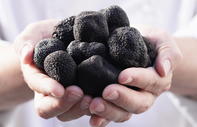These aromatic underground ‘mushrooms’ are highly prized in fine dining circles. Found in the wild amongst the roots of specific tree species, truffles can also be cultivated and requires a cold climate and alkaline, well-drained soil types.

What is a Truffle?
Truffles are the fruiting bodies of underground mycorrhizal fungi found near the roots of specific trees, such as oak, poplar and pine trees. Unlike other mushrooms such as the button mushroom (Agaricus species) which grows on a compost substrate, the truffle forms a symbiotic relationship with tree roots.
Truffles don’t look like mushrooms but look like round, dimpled or wart-like rocks with a beige/light brown, dark brown or black colour.
Truffles have an intense earthy aroma with hints of cheese, garlic, sometimes musk, nuts or fruit, depending on the type. This aroma is detected by trained sniffer dogs which will lead its handler to where truffles can be dug up.

Types of Truffles
There are over 40 truffle species, but just a few have market value and some are only available in the wild. The two most valued truffles are white and black truffles. The white truffle (Tuber magnatum) is also known as the Alba truffle and is found in the region of that name. The white truffle is rare and the most expensive of all truffles.
The winter black truffle (Tuber melanosporum) grows all over Western Europe and specifically in the Périgord region of France, and is often called the Périgord truffle. It has a more intense aroma than the white truffle.
Other cultivated truffles (apart from the white and black truffle) include Winter truffle (Tuber brumale), Summer truffle (Tuber aestivum var. aestivum), the Burgundy truffle (Tuber aestivum var. uncinatum), as well as the Oregon black and white truffles. The two Oregon truffles are found and cultivated in the USA and have delicate tropical flavours with notes of strawberry. Oregon truffles are often combined with desserts.
In South Africa, the Périgord truffle (winter black truffle) is most produced, but some truffle farmers have decided on Tuber aestivum and Tuber brumale. Aestivum is a summer truffle and Brumale is another winter truffle.
Truffle Producing Countries
Due to the huge value of truffles, much secrecy surrounds truffle production in the world. It is estimated that Spain now leads truffle production with an estimated 60 tonnes (in 2018) followed by Italy (30 tonnes) and France. Since 1999, Australian truffle production grew to a similar amount to France.
Other southern hemisphere truffle producers are New Zealand, Tasmania, Chile and South Africa.
By Marinda Louw